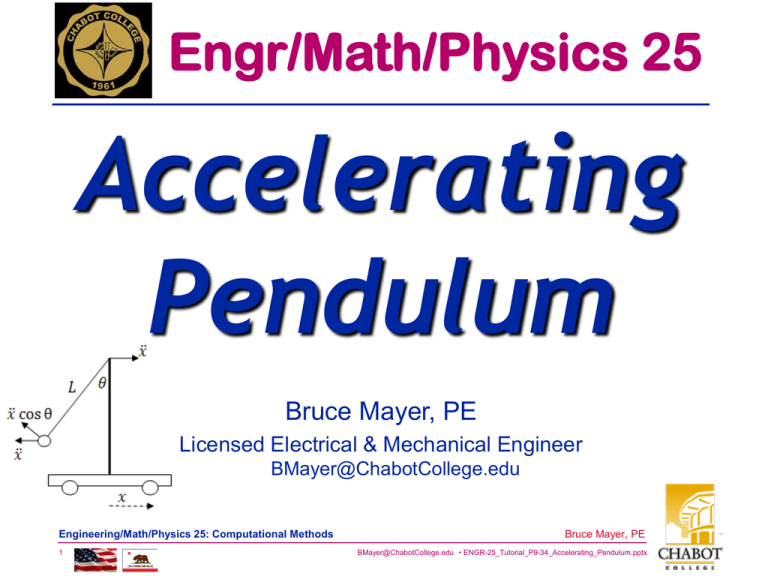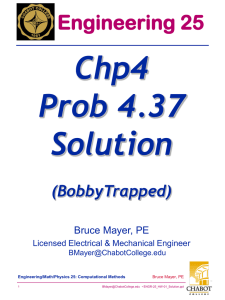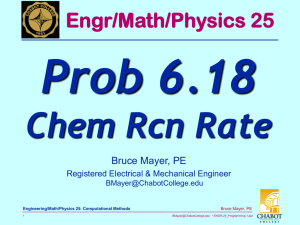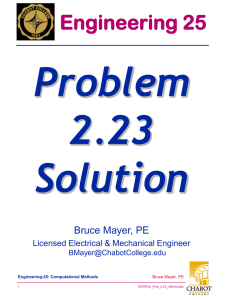Accelerating Pendulum Engr/Math/Physics 25 Bruce Mayer, PE
advertisement

Engr/Math/Physics 25
Accelerating
Pendulum
Bruce Mayer, PE
Licensed Electrical & Mechanical Engineer
BMayer@ChabotCollege.edu
Engineering/Math/Physics 25: Computational Methods
1
Bruce Mayer, PE
BMayer@ChabotCollege.edu • ENGR-25_Tutorial_P9-34_Accelerating_Pendulum.pptx
Recall 3rd order Transformation
d3y
d2y
dy
3 2 7 19 y 73 ln t 5 OR
3
dt
dt
dt
y 3 y 7 y 19 y 73 ln t 5
y 7 4
dy
and IC' s :
y 7 3
dt t 7
d2y
y 7 2
2
dt t 7
Engineering/Math/Physics 25: Computational Methods
2
Bruce Mayer, PE
BMayer@ChabotCollege.edu • ENGR-25_Tutorial_P9-34_Accelerating_Pendulum.pptx
A 3rd order Transformation (2)
dy
d 2 y
x1 y x 2
y x3 2 y
dt
dt
dx1
x1 y
x2
dt
dx2
x2 y
x3
dt
dx3
x3 y
dt
y 3 y 7 y 19 y 73 ln t 5 OR
x 3 3 x3 7 x2 19 x1 73 ln t 5
Engineering/Math/Physics 25: Computational Methods
3
Bruce Mayer, PE
BMayer@ChabotCollege.edu • ENGR-25_Tutorial_P9-34_Accelerating_Pendulum.pptx
A 3rd order Transformation (3)
Thus the 3-Eqn 1st Order ODE System
dx1 dt x1 x2
dx2 dt x 2 x3
dx3 dt x 3 73 ln t 5 3 x3 7 x2 19 x1
y 7 x1 7 4
y 7 x2 7 3
y 7 x3 7 2
Engineering/Math/Physics 25: Computational Methods
4
IC - 1
IC - 2
IC - 3
Bruce Mayer, PE
BMayer@ChabotCollege.edu • ENGR-25_Tutorial_P9-34_Accelerating_Pendulum.pptx
1
2
3
ODE: LittleOnes out of BigOne
V=
5
S=
C=
Engineering/Math/Physics 25: Computational Methods
Bruce Mayer, PE
BMayer@ChabotCollege.edu • ENGR-25_Tutorial_P9-34_Accelerating_Pendulum.pptx
ODE: LittleOnes out of BigOne
Engineering/Math/Physics 25: Computational Methods
6
Bruce Mayer, PE
BMayer@ChabotCollege.edu • ENGR-25_Tutorial_P9-34_Accelerating_Pendulum.pptx
ODE: LittleOnes out of BigOne
Engineering/Math/Physics 25: Computational Methods
7
Bruce Mayer, PE
BMayer@ChabotCollege.edu • ENGR-25_Tutorial_P9-34_Accelerating_Pendulum.pptx
ODE: LittleOnes out of BigOne
8
Engineering/Math/Physics 25: Computational Methods
Bruce Mayer, PE
BMayer@ChabotCollege.edu • ENGR-25_Tutorial_P9-34_Accelerating_Pendulum.pptx
Engineering/Math/Physics 25: Computational Methods
9
Bruce Mayer, PE
BMayer@ChabotCollege.edu • ENGR-25_Tutorial_P9-34_Accelerating_Pendulum.pptx
Problem 9.34
Accelerating Pendulum
For an Arbitrary LateralAcceleration Function, a(t),
the ANGULAR Position, θ, is
described by the (nastily)
NONlinear 2nd Order,
Homogeneous ODE
L g sin at cos 0
at
L
m
W = mg
• See next Slide for Eqn Derivation
Solve for θ(t)
Engineering/Math/Physics 25: Computational Methods
10
Bruce Mayer, PE
BMayer@ChabotCollege.edu • ENGR-25_Tutorial_P9-34_Accelerating_Pendulum.pptx
at
L
m
W = mg
Engineering/Math/Physics 25: Computational Methods
11
Bruce Mayer, PE
BMayer@ChabotCollege.edu • ENGR-25_Tutorial_P9-34_Accelerating_Pendulum.pptx
Prob 9.34: ΣF = Σma
at cos
at
L
T
n
N-T CoORD Sys
ds Ld
m
ds
d
ds Ld
L
L
dt
dt
d 2 s
d 2
s L 2 L
2
dt
dt
FT W sin
abase,T at cos
mg sin m L at cos
W sin
aS ,T L
W = mg
Engineering/Math/Physics 25: Computational Methods
12
Use Normal-Tangential
CoOrds; θ+ → CCW
Use ΣFT = ΣmaT
Bruce Mayer, PE
BMayer@ChabotCollege.edu • ENGR-25_Tutorial_P9-34_Accelerating_Pendulum.pptx
Prob 9.34: Simplify ODE
Cancel m:
−𝑚𝑔 sin 𝜃 = 𝑚 𝐿𝜃 − 𝑎 𝑡 cos 𝜃
Collect All θ terms on L.H.S.
𝐿𝜃 + 𝑔 sin 𝜃 − 𝑎 𝑡 cos 𝜃 = 0
at
Next make Two Little
Ones out of the Big One
• That is, convert the
ODE to State Variable Form
L
m
W = mg
Engineering/Math/Physics 25: Computational Methods
13
Bruce Mayer, PE
BMayer@ChabotCollege.edu • ENGR-25_Tutorial_P9-34_Accelerating_Pendulum.pptx
Convert to State Variable Form
Let: 𝑢1 = 𝜃 → 𝑑𝑢1 𝑑𝑡 = 𝑢2 = 𝜃
Thus: 𝑑𝜃 𝑑𝑡 = 𝜃 or 𝑑𝑢2 𝑑𝑡 = 𝜃
Then the 2nd derivative
𝑑2 𝜃
𝑎 𝑡 ∙ cos 𝑢 − 𝑔 ∙ sin 𝑢
𝑑𝑢2
=
=
2
𝑑𝑡
𝐿
𝑑𝑡
Have Created Two 1st Order Eqns
Engineering/Math/Physics 25: Computational Methods
14
Bruce Mayer, PE
BMayer@ChabotCollege.edu • ENGR-25_Tutorial_P9-34_Accelerating_Pendulum.pptx
SimuLink Solution
The ODE using y in place of θ
2
d y
L 2 g sin y at cos y 0
dt
Isolate Highest d 2 y at cos y g sin y
2
Order Derivative dt
L
Double Integrate to find y(t)
at cos y g sin y
y
dt dt
L
Engineering/Math/Physics 25: Computational Methods
15
Bruce Mayer, PE
BMayer@ChabotCollege.edu • ENGR-25_Tutorial_P9-34_Accelerating_Pendulum.pptx
SimuLink Diagram
Engineering/Math/Physics 25: Computational Methods
16
Bruce Mayer, PE
BMayer@ChabotCollege.edu • ENGR-25_Tutorial_P9-34_Accelerating_Pendulum.pptx
All Done for Today
Foucault
Pendulum
While our clocks are set by an average 24 hour day for the passage
of the Sun from noon to noon, the Earth rotates on its axis in 23
hours 56 minutes and 4.1 seconds with respect to the rest of the
universe. From our perspective here on Earth, it appears that the
entire universe circles us in this time. It is possible to do some
rather simple experiments that demonstrate that it is really the
rotation of the Earth that makes this daily motion occur.
In 1851 Leon Foucault (1819-1868) was made famous when he devised an experiment with a pendulum that demonstrated the
rotation of the Earth.. Inside the dome of the Pantheon of Paris he suspended an iron ball about 1 foot in diameter from a wire
more than 200 feet long. The ball could easily swing back and forth more than 12 feet. Just under it he built a circular ring on
which he placed a ridge of sand. A pin attached to the ball would scrape sand away each time the ball passed by. The ball was
drawn to the side and held in place by a cord until it was absolutely still. The cord was burned to start the pendulum swinging
in a perfect plane. Swing after swing the plane of the pendulum turned slowly because the floor of the Pantheon was moving
under the pendulum.
Engineering/Math/Physics 25: Computational Methods
17
Bruce Mayer, PE
BMayer@ChabotCollege.edu • ENGR-25_Tutorial_P9-34_Accelerating_Pendulum.pptx
Engineering/Math/Physics 25: Computational Methods
18
Bruce Mayer, PE
BMayer@ChabotCollege.edu • ENGR-25_Tutorial_P9-34_Accelerating_Pendulum.pptx
Prob 9.34 Script File
% Bruce Mayer, PE * 05Nov11
% ENGR25 * problem 9.34
% file = Demo_Prob9_34.m
%
%This script file calls FUNCTION pendacc
%
clear
% clears memory
global m b;
% globalize accel calc constants
% Acceleration, a(t) = m*t + b
% ask user for max time; suggest starting at 25
tmax = input('tmax = ');
%
%set the case consts, and IC's y(0) & dy(0)/dt
%=> remove the leading "%" to toggle between cases
m = 0, b = 5, y0 = [0.5 0]; % case-a
%m = 0, b = 5, y0 = [3 0]; % case-b
%m = 0.5, b = 0, y0 = [3 0]; % case-c
% m = 0.4, b = -4, y0 = [1.7 2.3]; % case-d => EXTRA
%
%Call the ode45 routine with the above data inputs
[t,x]=ode45('pendacc', [0, tmax], y0);
%
%PLot theta(t)
subplot(1,1,1)
plot(t,x(:,1)), xlabel('t (sec)'), ylabel('theta (rads)'),...
title('P9.34 - Accelerating Pendulum'), grid;
disp('Plotting ONLY theta - Hit Any Key to continue')
pause
%Plot the FIRST column of the solution “matrix”
%giving x1 or y.
subplot(2,1,1)
plot(t,x(:,1)), xlabel('t (sec)'), ylabel('theta (rads)'),...
title('P9.34 - Accelerating Pendulum'), grid;
%Plot the SECOND column of the solution “matrix”
%giving x2 or dy/dt.
subplot(2,1,2)
plot(t,x(:,2)), xlabel('t (sec)'), ylabel('dtheta/dt (r/s)'), grid;
disp('Plotting Both theta and dtheta/dt; hit any key to continue')
Prob 9.34 Function File
function dxdt = pendacc(t_val,z);
% Bruce Mayer, PE * 05Nov05
% ENGR25 * Prob 8-30
%
%This is the function that makes up the system
%of differential equations solved by ode45
%
% the Vector z contains yk & [dy/dt]k
%
%Globalize the Constants used to calc the Accel
global m b
% set the physical constants
L = 1;
% in m
g = 9.81;
% in m/sq-Sec
%
%DEBUG § => remove semicolons to reveal t_val & z
t_val; z;
%
% Calc the Cauchy (State) values
dxdt(1)= z(2); % at t=0, dxdt(1) = dy(0)/dt
dxdt(2)= ((m*t_val + b)*cos(z(1)) - g*sin(z(1)))/L;
% at t = 0, dxdt(2) =((m*t_val + b)*cos(y(0)) - g*sin(y(0)))/L;
%
% make the dxdt into a COLUMN vector
dxdt = [dxdt(1); dxdt(2)];
Engineering/Math/Physics 25: Computational Methods
19
Bruce Mayer, PE
BMayer@ChabotCollege.edu • ENGR-25_Tutorial_P9-34_Accelerating_Pendulum.pptx
Θ with Torsional Damping
The Angular Position, θ, of a linearly
accelerating pendulum with a Journal
Bearing mount that produces torsional
friction-damping can be described by this
second-order, non-linear Ordinary
Differential Equation (ODE) and Initial
Conditions (IC’s) for θ(t):
D
0 2.8 rads
L = 1.6 meters
n = 0.40 meters/sec3
Engineering/Math/Physics 25: Computational Methods
20
1.9 rads sec
m
t 0
D = 0.07 meters/sec
L
L D g sin n t bcos 0
d
0
dt
at
g = 9.8 meters/sec2
b = −3.0 meters/sec2
Bruce Mayer, PE
BMayer@ChabotCollege.edu • ENGR-25_Tutorial_P9-34_Accelerating_Pendulum.pptx
W = mg
Θ with Torsional Damping
E25_FE_Damped_Pendulum_1104.mdl
Engineering/Math/Physics 25: Computational Methods
21
Bruce Mayer, PE
BMayer@ChabotCollege.edu • ENGR-25_Tutorial_P9-34_Accelerating_Pendulum.pptx
plot(tout,Q, 'k', 'LineWidth', 2), grid,
xlabel('t (sec)'), ylabel('\theta (rads)'),
title('Accelerating Pendulum Angular
Position')
Θ with Torsional Damping
Accelerating Pendulum Angular Position
3
2
(rads)
1
0
-1
-2
-3
0
10
20
30
40
Engineering/Math/Physics 25: Computational Methods
22
50
t (sec)
60
70
80
90
100
Bruce Mayer, PE
BMayer@ChabotCollege.edu • ENGR-25_Tutorial_P9-34_Accelerating_Pendulum.pptx






